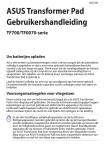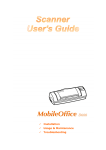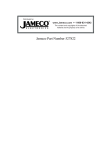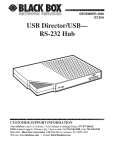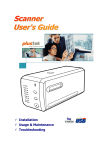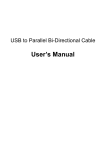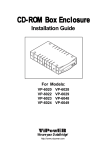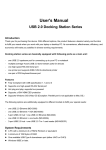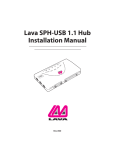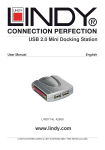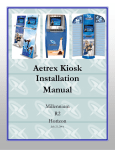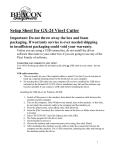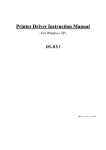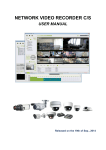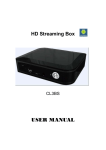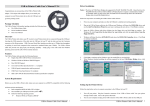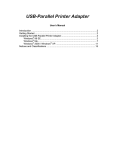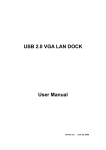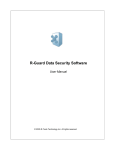Download User`s Manual USB DOCK - Einstein
Transcript
User's Manual USB DOCK - Einstein Omnidirectional Control Technology Inc. Omnidirectional Control Technology Index INTRODUCTION..................................................................................................................................................3 SYSTEM REQUIREMENTS.....................................................................................................................................3 PACKAGE CONTENTS...........................................................................................................................................3 CONNECTORS........................................................................................................................................................4 USB DOCK FUNCTIONS ....................................................................................................................................4 LED INDICATOR ...................................................................................................................................................5 INSTALLING USB DOCK..................................................................................................................................6 DRIVER INSTALLATION........................................................................................................................................7 SET UP THE PRINTER DEVICE ...........................................................................................................................18 SET UP THE HYPERTERMINAL WITH USB TO SERIAL PORT ..........................................................................21 UNINSTALLING THE DRIVER PROGRAM ..........................................................................................................23 APPLICATION NOTE...................................................................................................................................... 24 USB-DOCK User’s Manual -2- Omnidirectional Control Technology Introduction Thank you for ordering the USB DOCK. The USB DOCK is an intelligent expansion module which connects to a PC or notebook via Universal Serial Bus (USB) port, providing one high-speed RS-232 serial port, one printer port, one PS/2 keyboard & mouse and 4 downstream USB ports. The USB DOCK features easy connectivity for traditional serial devices, keyboard, mouse and other USB devices. By simply plugging in an USB DOCK, you will: l Add one high-speed serial port, one printer port, one PS/2 keyboard & mouse and 4 downstream USB ports to your PC or notebook in seconds. l Improve the inconvenience of configuring old PC solutions like card extension solutions, which require to adjust IRQ or jumper settings and the incompatibility of various brands of docking solution or bus repeater. l Avoid the hassle of removing your PC case, or rebooting the operating system during installation. System Requirements l l l l A PC with a minimum of a 75MHz Pentium, or equivalent A minimum of 16M bytes of RAM. One available USB type A downstream port. ( either UHCI or OHCI ) Windows 98 or later. Package Contents The product you purchase should contain the equipment and accessories shown as follows: l USB DOCK converter l One 6 feet USB AB type cable l One 1.8A switching power adapter (optional) l One USB DOCK driver and User’s manual CD USB-DOCK User’s Manual -3- Omnidirectional Control Technology Connectors l One DB-9 RS-232 serial interface connector supports baud rates from 1,200 to 115.2K. l One DB-25 parallel connector supports IEEE-1284 bi-directional printer port. l One Mini-din for PS/2 keyboard, mouse. l Four USB receptacle type A downstream ports. l One USB type B upstream connector. Figure 1 USB DOCK Functions The available functions of USB DOCK depend on the status of power supplied: l Bus powered 1. Connecting USB cable to PC to provide bus power. 2. When you provide bus power only, the PS/2 mouse & keyboard, RS232 and printer functions will be enabled. However, the USB Downstream Ports are disabled. l External powered 1. Connecting power adapter to provide external power. 2. When you provide external power, the USB Downstream Ports are enabled, and you can use all the functions of USB DOCK. USB-DOCK User’s Manual -4- Omnidirectional Control Technology LED Indicator l Power Indicator The Power Indicator will turn ON when bus power is supplied. l USB Indicators There are four USB indicators to show if the USB Downstream Ports are ready for use. 1. If the USB DOCK is not ready for use or only bus power is supplied, the USB Indicators will turn OFF, and the USB Downstream Ports can not be used. 2. If the USB DOCK is ready for use, and external power is supplied, the USB Indicators will turn ON, and you can use all the functions of USB DOCK. 3. If over-current happens for certain USB Downstream Port, the corresponding USB Indicator will turn OFF to indicate that this port is not working now. 4. When over-current situation is solved, the USB Indicator will turn ON again. Figure 2 USB-DOCK User’s Manual -5- Omnidirectional Control Technology Installing USB DOCK 1. This installation guide is written in accordance with Windows 98/98SE. For Windows 2000/XP, the step A, B, and C of the "Driver Installation" section will be skipped. 2. Power on your computer and make sure that the USB port is enabled and working properly. Please refer to the "application note 1” if you have any trouble. 3. Connect the power adapter into USB DOCK. 4. Connect the USB cable into USB DOCK and the USB port of your PC. 5. Windows will first detect the HUB device. Install HUB using operating system software. Please refer to step A of "Driver Installation" section. (This section for Windows 98 only) 6. Windows will detect the IEEE-1284 device. Please refer to step B of "Driver Installation" section. (This section for Windows98/98SE/Me only) 7. Windows will detect the PS/2 keyboard & mouse device. Please refer to step C, the "Driver Installation" section. 8. And Windows will detect the RS232 device. Please refer to step D of "Driver Installation" section. USB-DOCK User’s Manual -6- Omnidirectional Control Technology Driver Installation The driver installation is divided into 4 steps. Please install USB DOCK step by step by following the instruction from Step A-D. Step A: (This step for Windows 98 only) To install the HUB function of the USB DOCK: A1. Click “Next” to Continue (Ref Figure A-1) Figure A-1 A2. Click “Next” to initiate a search for the best driver for your device (Ref Figure A-2) Figure A-2 A3. Please insert the “Windows 98” CD into CD-ROM. Click “Next” to continue (Ref Figure A-3) Figure A-3 USB-DOCK User’s Manual -7- Omnidirectional Control Technology A4. Click “Next” to continue (Ref Figure A-4) Figure A-4 A5. Click “Next” to continue (Ref Figure A-5) Figure A-5 A6. Click “Finish”, Windows has finished installing USB Hub driver (Ref Figure A-6) Figure A-6 USB-DOCK User’s Manual -8- Omnidirectional Control Technology Step B: (This section for Windows98/98SE/Me only) To install the software for USB to Printer Converter of the USB DOCK: B1. Insert the “USB DOCK driver diskette” into drive A. Click “Next” to continue (Ref Figure B-1) Figure B-1 B2. Click “Next” to initiate the search for the best driver for your device (Ref Figure B-2). Figure B-2 B3. Selected Floppy diskette drives location as "A:\Win98". Click “Next” to start and search. (Ref Figure B-3). Figure B-3 USB-DOCK User’s Manual -9- Omnidirectional Control Technology B4. Click “Next” to continue (Ref Figure B-4) Figure B-4 B5. Click “Finish”, windows has finished installing the printer driver (Ref Figure B-5) Figure B-5 Before connecting the printer on the parallel port of USB DOCK-Einstein, the printer driver must be installed in advance, or it might print unknow format of character. Please refer "Setting Up the Printer Device" section to connect your printer to the USB DOCK. USB-DOCK User’s Manual - 10 - Omnidirectional Control Technology Step C. (This section for Windows98/98SE only) To install the PS/2 keyboard & mouse driver of USB DOCK: C1. Click “Next” to continue (Ref Figure C-1) Figure C-1 C2. Click “Next” to initiate search for the best driver for your device (Ref Figure C-2) Figure C-2 C3. Please insert “Windows 98” CD into CD-ROM drive. Click “Next” to continue (Ref Figure C-3) Figure C-3 USB-DOCK User’s Manual - 11 - Omnidirectional Control Technology C4. Click “Next” to continue (Ref Figure C-4) Figure C-4 C5. Click “Finish”, Windows has finished installing the USB HID driver for PS/2 keyboard & mouse. (Ref Figure C-5) Figure C-5 USB-DOCK User’s Manual - 12 - Omnidirectional Control Technology Step D: To install the USB to serial port driver of the USB DOCK, please make sure the driver diskette is inserted: D1. Click “Next” to continue (Ref Figure D-1) Figure D-1 D2. Click “Next” to initiate a search for the best drive for your device (Ref Figure D-2) Figure D-2 D3. Select Floppy diskette drives location. Click “Next” to start and search for the best driver for your device (Ref Figure D-3) Figure D-3 USB-DOCK User’s Manual - 13 - Omnidirectional Control Technology D4. Click “Next” to continue (Ref Figure D-4) Figure D-4 D5. Click “Finish”, Windows has finished installing RS-232 port driver (Ref Figure D-5) Figure D-5 USB-DOCK User’s Manual - 14 - Omnidirectional Control Technology Step E. (For Windows 2000/XP only) To install the USB to serial port driver of the DOCK COMMANDER, please make sure the driver diskette/CD is inserted: E1. Click “Next” to continue (Ref Figure E-1) Figure E-1 E2. Click “Next” to initiate search for the best driver for your device (Ref Figure E-2) Figure E-2 E3. Please insert “Dock Commander Driver” diskette/CD into Floppy/CD-ROM drive and specify the location. Click “Next” to continue (Ref Figure E-3) Figure E-3 USB-DOCK User’s Manual - 15 - Omnidirectional Control Technology E4. Click “Next” to continue (Ref Figure E-4) Figure E-4 E5. Click “Finish”, Windows has finished installing Serial port driver. (Ref Figure E-5) Figure E-5 l l Before connecting the modem on the serial port of USB DOCK, the modem driver must be installed in advance, otherwise it might operate unexpectedly. Please refer to "Setting Up the HyperTerminal with USB to serial port" section as an example of routing your COM port setting. USB-DOCK User’s Manual - 16 - Omnidirectional Control Technology Congratulations!! You have finished installing USB DOCK. Please click on Start, Settings, Control Panel, double click System, and click on Device Manager. Double check the Human Interface Devices, Keyboard, Mouse, Ports, and Universal serial bus controller of the dialog box to see if they work properly. Figure 3 Figure 4 USB-DOCK User’s Manual - 17 - Omnidirectional Control Technology Set Up the Printer Device Follow the steps below to connect your printer to the USB DOCK with your PC: For Windows 98/98SE and Me: 1. Turn off your printer. Plug the cable to connect USB DOCK parallel port and printer. Turn on the printer afterwards. 2. Turn on your computer and plug in the USB cable to connect the USB DOCK and the USB port of PC. 3. Please click on Start, Settings, Control Panel, double click System, and click on Device Manager. Check which printer port is located by USB to parallel port. The following example is located as LPT2. Figure 5 4. If you have installed a printer device before, click Start, Settings, Printers. Right-click the default installed printer and click on Properties. The Properties dialog box of the installed printer will appear on your screen. 5. Click the Details folder tab and change the printer port to LPT2: (USB to Parallel Port). USB-DOCK User’s Manual - 18 - Omnidirectional Control Technology Figure 6 6. If you do not have a printer installed yet, click on Start, Settings, Printers, Add Printer. The Add Printer Wizard will start and assist you in installing a new printer device. Select the printer manufacturer and model name from the list provided by the wizard or use the printer driver diskette supplied by your printer. 7. When prompted which port the printer will use, click on LPT2: USB to Parallel Port. Figure 7 8. Follow the succeeding instructions to complete the installation and run Print Test Page to see if it can print without problems. USB-DOCK User’s Manual - 19 - Omnidirectional Control Technology For WINDOWS 2000 and XP: 1. Turn off your printer. Plug the cable to connect USB PORT REPLICATOR parallel port and printer. Turn on the printer afterwards. 2. Turn on your computer and plug in the USB cable to connect the USB PORT REPLICATOR and the USB port of PC. 3. If you have installed a printer device before, click Start, Settings, Printers. Right-click the default installed printer and click on Properties. The Properties dialog box of the installed printer will appear on your screen. 4. Click the Ports tab and change the printer port to USB001 (Virtual printer port to USB). Figure 17 5. If you do not have a printer installed yet, click on Start, Settings, Printers, Add Printer. The Add Printer Wizard will start and assist you in installing a new printer device. Select the printer manufacturer and model name from the list provided by the wizard or use the printer driver diskette supplied by your printer. 6. When prompted which port the printer will use, click on USB001 (Virtual printer port to USB). Figure 18 USB-DOCK User’s Manual - 20 - Omnidirectional Control Technology Set up the HyperTerminal with USB to serial port Follow the steps below to configure your HyperTerminal with USB to serial COM port setting: 1. Make sure that HyperTerminal is installed in your system. If not, please click Start, Settings, Control Panel, double click Add/Remove Programs, choose Windows Setup page, Communications, click Details button, enable HyperTerminal to install the program to your Windows system. 2. Please click on Start, Settings, Control Panel, double click System, and click on Device Manager. Check which COM port is located by USB to serial port. Figure 8 3. If you have setup HyperTerminal before, please run Start, Programs, Accessories, Communications, HyperTerminal, HyperTrm.exe. Click File, Properties. The Properties dialog page will appear on your screen. If you are first time to setup HyperTerminal, you will see this page during the setup procedure. USB-DOCK User’s Manual - 21 - Omnidirectional Control Technology Figure 9 4. Click the "Connect using" item to indicate the proper COM port which appeared in step 1, and follow the succeeding instructions to complete the setup. USB-DOCK User’s Manual - 22 - Omnidirectional Control Technology Uninstalling the Driver Program If you want to remove the USB DOCK driver program, you can uninstall it by following the steps below: WINDOWS 98/98SE and Me: a. Unplug the USB cable from your PC. b. Run the Uninst_USBDock_98_Me.exe program from the USB DOCK driver diskette and reboot the PC. WINDOWS 2000 and XP: c. Unplug the USB cable from your PC. d. Run the Uninst_USBDock_2000_XP.exe program from the USB DOCK driver diskette. USB-DOCK User’s Manual - 23 - Omnidirectional Control Technology APPLICATION NOTE 1. Determine why support of USB port is not present: First, download Usbready.exe from the web site www.octinc.com.tw, if you have any problem to download, please contact us via [email protected]. Please run the program, and click the Details button, it will help you find the reason why USB support is disabled. l Click on the Details button. - If the USB class Host Controller windows displays “No USB Host Controller Found”, it means the USB Host Controller has not been detected. - If your PC does not have USB connector, this system will not support USB in any Windows Version. - For PC already with USB connector, check the USB Class Host controller to see if it displays any message like” Standard”, “Intel”, “ Universal”, or “Open” Host Controller, it means the hardware support is present under an incompatible version of Windows. 2. USB DOCK normally derives its own power from PC Host. When system power plugged in to the USB port of PC or notebook, the Large LED will turn green, and the serial, parallel, keyboard and mouse can operate without the switching adapter. Please note that the 4 downstream ports will not function before the power adapter is connected. However, you may use the power by connecting an external 5 voltage, 1.8A DC power which is UL, CE, T-mark or locally approved. For Polarity, see the following: 3. Unknown Device: If all the installation process has been completed and some of the devices still don't work, please go to: My Computer/Property/Device Manager/USB, check COM port, printer, keyboard, mouse or Hub to see if there are any “Unknown device” appear on the screen. You need to “Remove” and “Refresh”, start the installation processes again. After trying all the above mentioned process and your device still cannot work, please contact your technical people or send e-mail to: [email protected] USB-DOCK User’s Manual - 24 - Omnidirectional Control Technology Disclaimer Information in this document is subject to change without notice. The manufacturer does not make any representations or warranties (implied or otherwise) regarding the accuracy and completeness of this document and shall in no event be liable for any loss of profit or any other commercial damage, including but not limited to special, incidental, consequential, or other damages. No part of this document may be reproduced or transmitted in any form by any means, electronic or mechanical, including photocopying, recording or information recording and retrieval systems without the express written permission of the manufacturer. All brand names and product names used in this document are trademarks, or registered trademarks of their respective holders. FCC Statement This device generates and uses radio frequency and may cause interference to radio and television reception if not installed and used properly. This has been tested and found to comply with the limits of a Class B computing device in accordance with the specifications in Part 15 of FCC Rules. These specifications are designed to provide reasonable protection against such interference in a residential installation. However, there is no guarantee that interference will not occur in a particular installation. If this device does cause harmful interference to radio or television reception, which can be determined by plugging the device in and out, the user can to try to correct the interference by one or more of the following measures: • • • • Reorient or relocate the receiving antenna. Increase the separation between the device and receiver. Connect the computer into an outlet on a circuit different from that to which the receiver is connected. Consult the dealer or an experienced radio/TV technician for help. Technical support: TEL: 886 2 2910 7090 E-mail: [email protected] USB-DOCK User’s Manual - 25 -


























